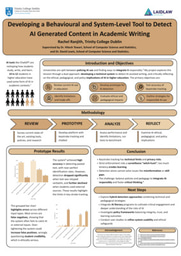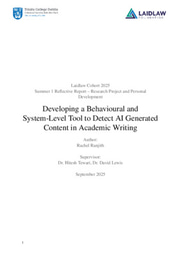Summer 1 Experience: Developing a Behavioural and System-Level Tool to Detect AI Generated Content in Academic Writing

When I initially planned my methodology for Summer 1, I was fairly confident that it would be a purely technical project. The aim was to build a tool that utilized behavioural cues to detect AI-generated content in academic writing, as opposed to most current AI-detectors that rely on syntactical structures. If we could track how students typed and monitor their clipboard activity, we could spot reasonably suspicious behavior. However, what I didn't expect was how quickly the project would push me beyond the technical layer and into deeper questions about ethics, pedagogy, and leadership.
On the technical side, I managed to build a prototype. It tracked keystrokes, clipboard activity, and interactions with an internal AI chatbot. At first, the results looked promising. Clipboard logging worked well; it flagged when students pasted chunks of text directly. But verbatim text retyped from external AI tools or lightly edited chatbot responses slipped through almost undetected. To address this, I experimented with measuring typing speed and rhythm. While these refinements reduced false negatives, they introduced a new problem: an alarming rate of false positives. Suddenly, students who were writing normally could be flagged as dishonest. That forced me to confront a bigger question—was this kind of close surveillance ethical in the first place?
That question reshaped the project. Detecting dishonesty was only half the story; protecting student integrity was just as important. A system that wrongly accuses students risks serious damage: mistrust, stress, and unfair consequences. This realisation meant I couldn’t just think like an engineer chasing accuracy rates. I also had to consider the ethical implications of the system itself. What values are reinforced when we treat every student as a suspect? How do we balance efficiency with fairness? It became clear that the technical fixes couldn’t be separated from ethical ones, and ignoring that would undermine the entire project.
The shift was profound. My focus moved from “Can we detect this?” to “Should we detect this?” And that opened up the most meaningful part of the summer. Suddenly, the project wasn’t only about building a system; it was about exploring how pedagogy, privacy, and leadership intersect. Leadership here wasn’t about providing quick fixes but about asking harder questions: not just whether a system works, but whether it works responsibly, and what alternatives might look like. These reflections spread beyond my own work, too. They fed into workshops with faculty and sparked conversations with professionals in education and healthcare, fields where trust and oversight are equally fragile.
Collaboration made this possible. My supervisors gave me space to explore, while offering guidance when I needed grounding. Fellow Laidlaw Scholars were another source of insight—we compared how AI shaped different disciplines, drawing parallels I wouldn’t have seen alone. Leading workshops gave me a chance to put ideas into practice, share lessons, and hear how others grappled with similar dilemmas.
Of course, the process wasn’t without its hurdles. Access to external data was limited, and without broad user testing I had to improvise methods. Balancing the project with other commitments stretched my time-management to its limit. But those challenges were part of the learning curve: they tested resilience, forced creative problem-solving, and highlighted that leadership isn’t only about meeting deadlines—it’s about being transparent, ethical, and reflective when things don’t go according to plan.
Looking back, Summer 1 gave me more than technical skills. It revealed the double edge of innovation: the potential to improve systems, but also the risk of undermining fairness if ethics are sidelined. The biggest takeaway? Responsible leadership in AI means creating systems that work and respect the people they affect. Sometimes, the most important step isn’t improving the system at all—it was about learning when to question the system itself.




Please sign in
If you are a registered user on Laidlaw Scholars Network, please sign in